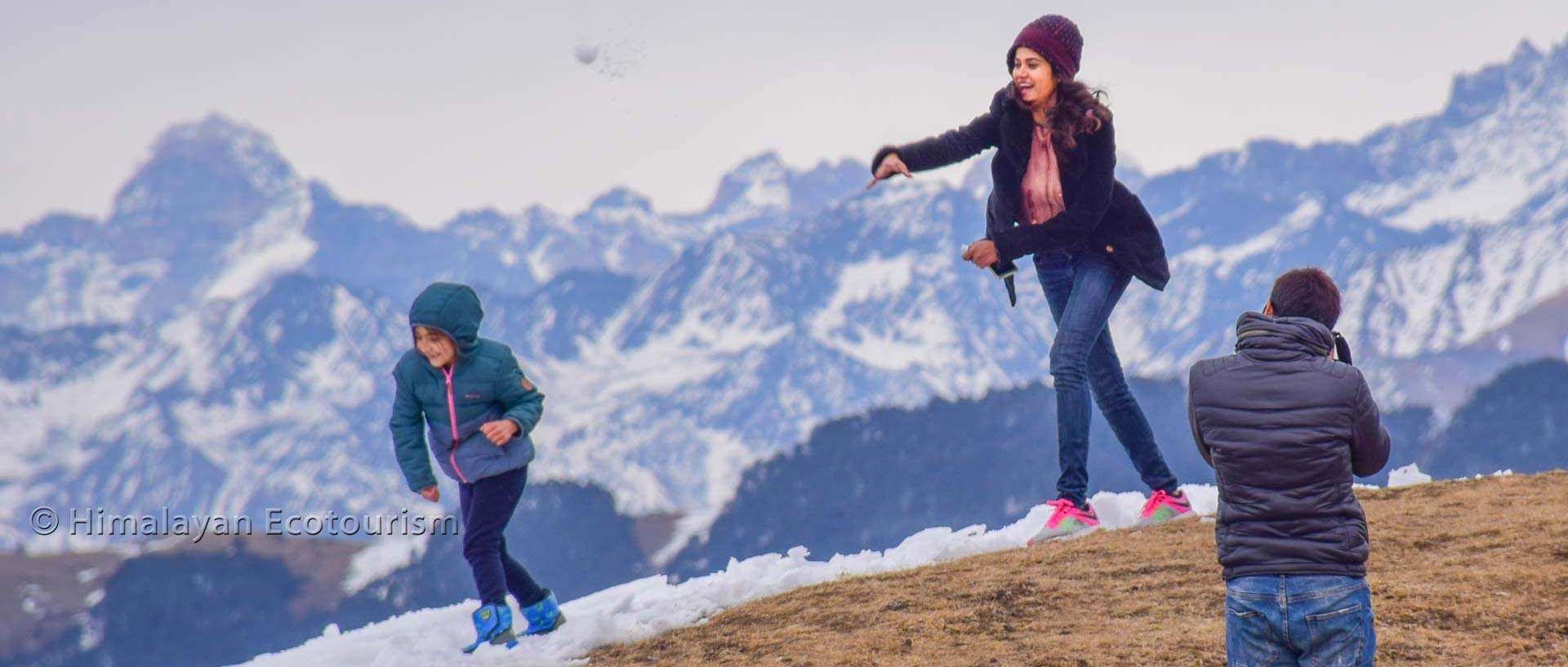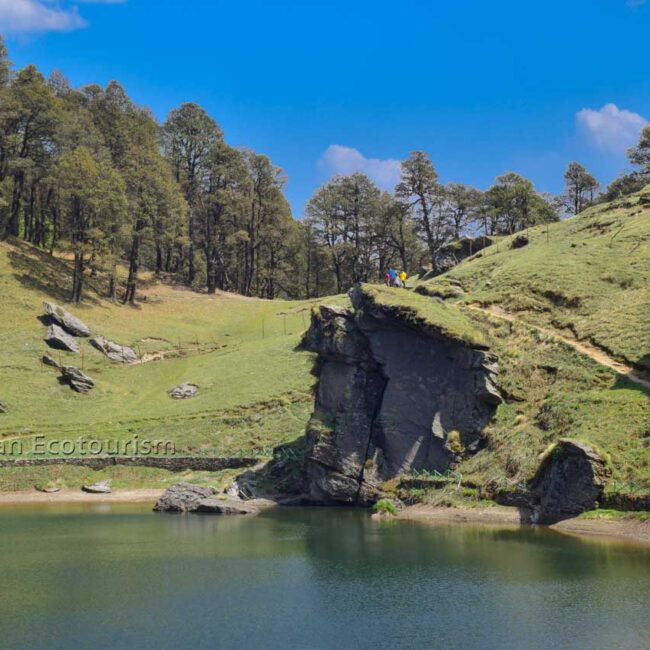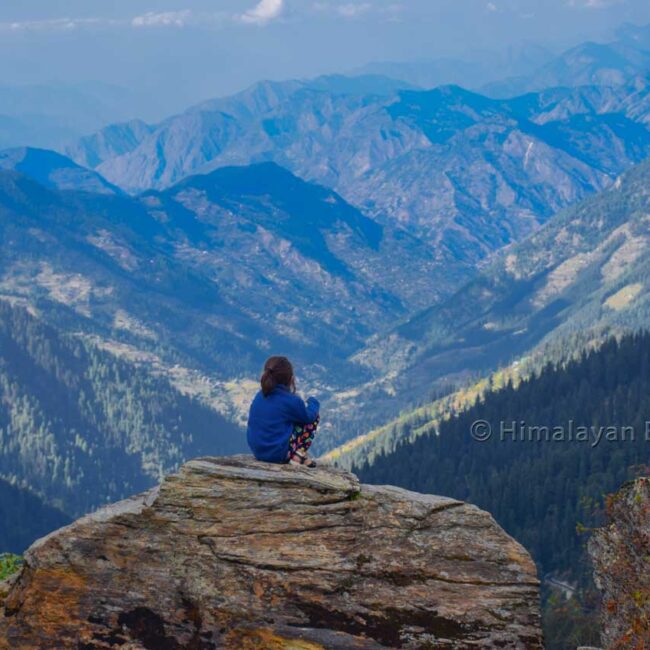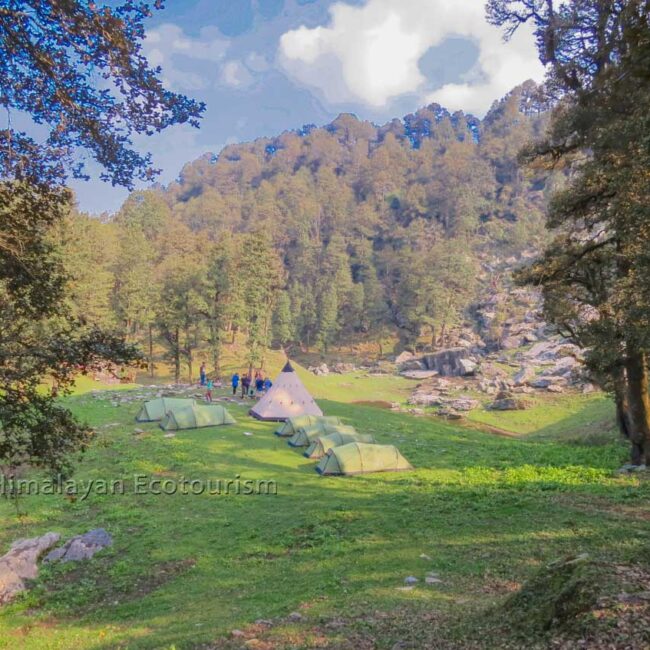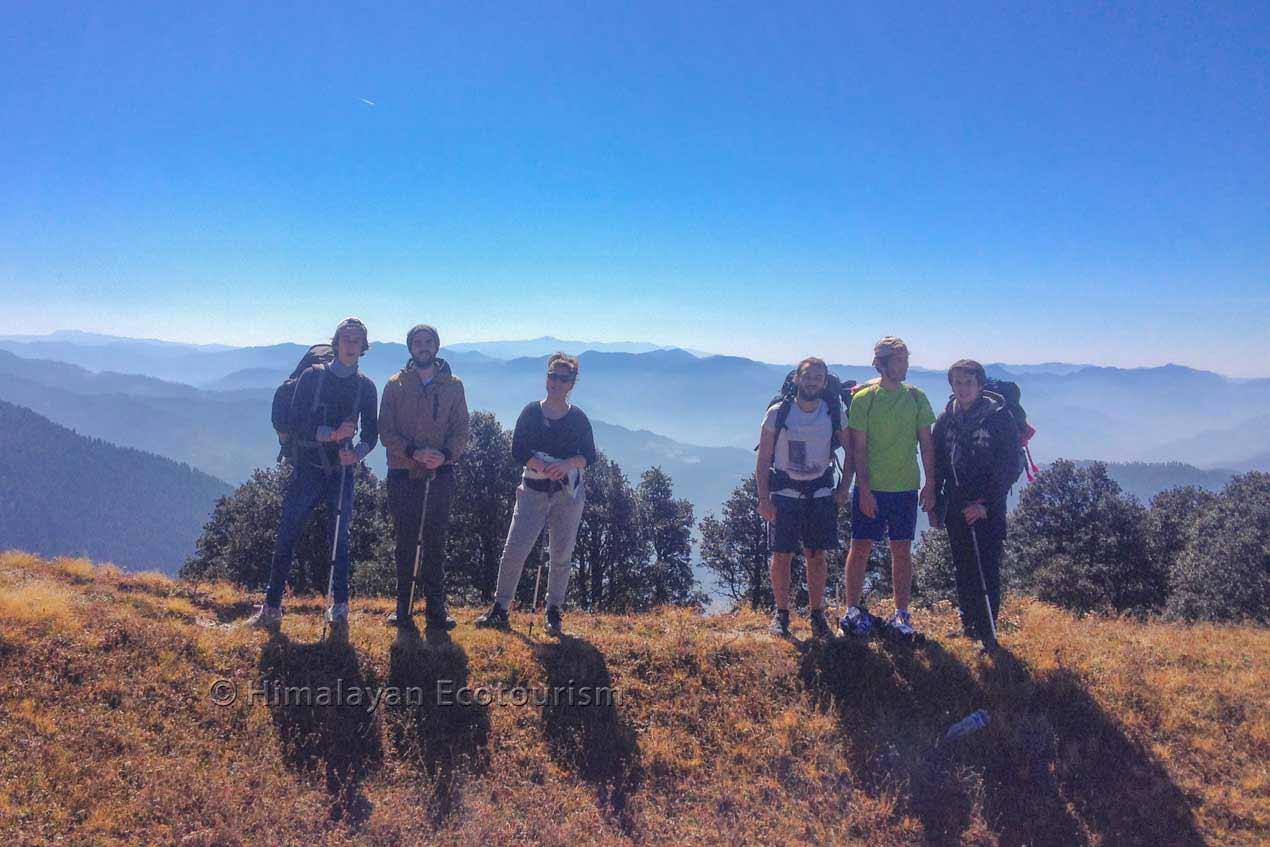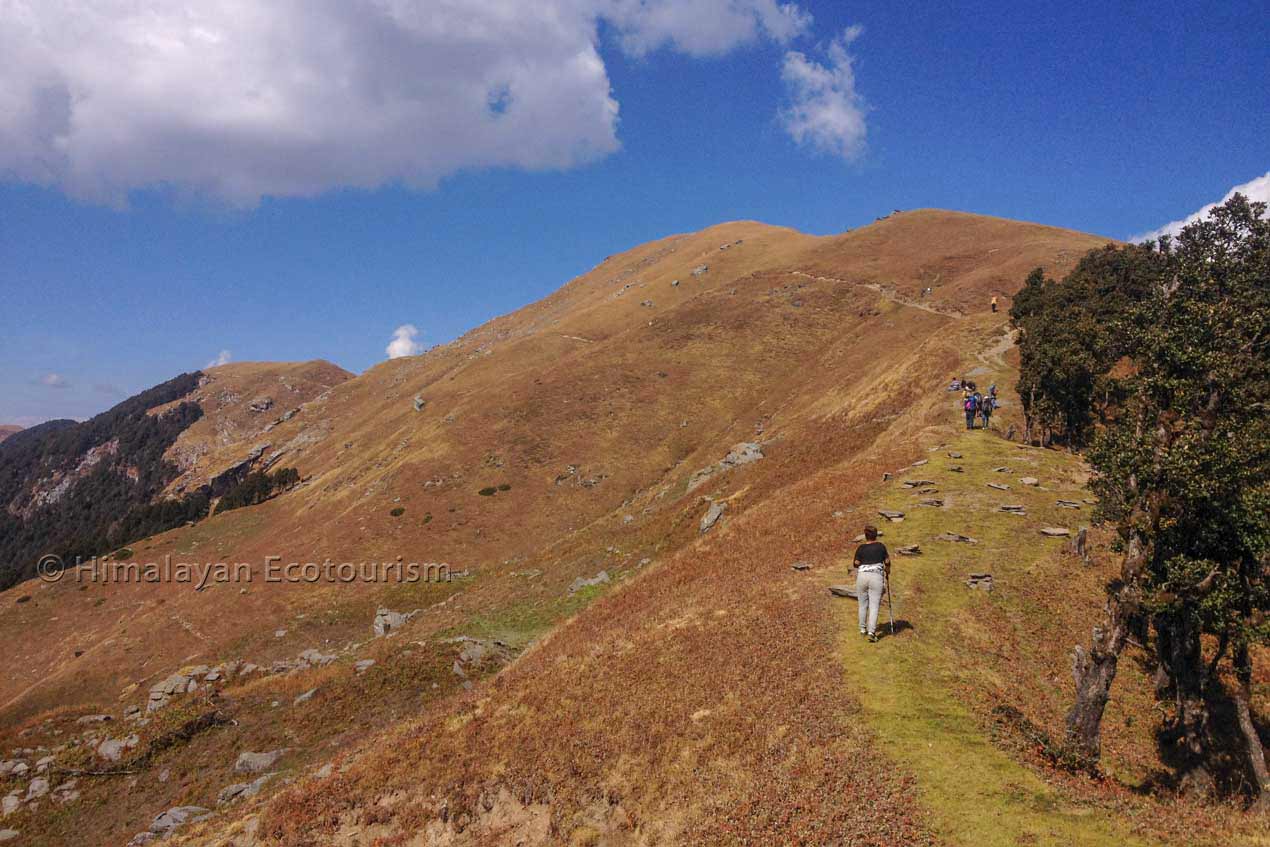Jalori Pass
Treks around Jalori pass
Enjoy the Himalayas above 3000 m in an easy way
Jalori Pass is a high-altitude mountain pass in Kullu, Himachal Pradesh. Jalori Pass’ height is around 3200 m and this allows you to experience high-altitude scenery and ecosystems. Because of its remote location and high-altitude atmosphere, a visit to the pass promises adventure. Jalori Pass’ 360 view of the Himalayan mountain range is one of the best views you will get this side of the western Himalayas.
We recommend a jeep safari to Jalori Pass by a road weaving through Himalayan forests. From Jalori Pass, you can then embark on day hikes or you can choose our easy camping in the wild package or a two- or three-day trekking adventure.


Jalori pass treks features
Duration of your trek
Day-min : The minimum number of days required for the trek
Day-max : The maximum number of days you can spend on this trek. Prolonged itinerary can be discussed with our team.
AWTD : Average walking time per day (<3 : easy, 3 to 5 : moderate, >5 : strenuous)
Altitudes of your trek
Min : Minimum altitude of your trek.
Max : Maximum altitude of your trek.
Ascent : The difference of altitude between the trek starting point and the highest point of the trek.
Descent : The difference of altitude between the highest point of the trek and the trek ending point.
Difficulty of your trek
Stamina : The physical effort involved during your trek. Rated from 0 (easiest) to 100 (most strenuous). If you have an average fitness you can consider all the treks up to 50. See here for more details
Technical : Difficulty of your trek in terms of exposure to danger and required experience.
0 to 20 : No difficulties,
20 to 40 : Walking on good mountain trails,
40 to 60 : Some walking on difficult mountain trails (steep slopes, rocks, etc.),
60 to 80: You are exposed to some dangers (void, snow, falling rocks, etc.),
80 to 100 : Experience required (please inquire).
Overall : Average between Stamina and Technical rating.
Serolsar lake
Duration
Altitudes
Difficulty
Bajah top
Duration
Altitudes
Difficulty

Jalori pass – Best time to go
Like for the Tirthan valley or for the Great Himalayan National Park, the best time to visit the Jalori pass is summer season (from April to June) and autumn season (October and November).
JAN
Avoid
FEB
Avoid
MAR
You may go
APR
Best time to go
MAY
Best time to go
JUN
Best time to go
JUL
You may go
AUG
Avoid
SEP
You may go
OCT
Best time to go
NOV
Best time to go
DEC
You may go
Jalori Pass Directions
Jalori Pass to Jibhi is 12km. It is a 40-minute drive and you’ll pass Shoja village.
Jalori Pass to Tirthan Valley is 30km and you’ll be taking the Sarchi road and NH305.
The distance from Delhi to Jalori Pass is around 500km and it’s a 12-hour drive.
Best Time to Visit Jalori Pass
The best time to visit Jalori Pass is in summer (April to June) and autumn (October to November). The temperature is cooler in the pass because of its high-altitude location. In fact, the temperature can drop to less than 10 degrees as compared to Jibhi.
It is not safe to trek to Jalori Pass during rainy season, usually, July to September, because of landslides and road blocks. Trails may be blocked because of trees falling.
Snowfall in winter (late December to early March) tends to be heavier here and roads are blocked during that time. However, we can arrange hikes and camping during lighter snowfall so that you can experience the beauty of the mountain pass when it is covered with snow. It is also a great time for a snowball fight, which kids will enjoy.
We recommend you check the temperature forecast or call us before planning a trip. The weather in high-altitude terrains can be unpredictable and you will need to prepare accordingly.
Jalori Pass Treks and Jalori Pass Camping
It’s a beautiful drive to Jalori Pass. We can arrange a jeep safari. The views from Jalori Pass, which sits at an altitude of 3000m, are fantastic. From here, you can go on day hikes to Raghupur Fort, Serolsar Lake, or Bajah Top. Each has its own charm.
Is the trek to Jalori pass difficult? If that is what you are wondering about, don’t worry. We will drive you up to the Pass and the hikes from there are easy to moderate in terms of difficulty.
If you have more time, you can turn this into a two- or three-day trekking adventure, including camping. Our easy camping in the wild concept will ensure you have a great camping experience with high-quality tents, good food, and a full staff.
Jalori Pass snow
The Jalori pass offers a wonderful opportunity to easily reach the snowline from December to April. Despite of reaching the pass by car, we recommend you to leave your vehicle or taxi at the village Sojha (or even spend the night there) and continue on foot towards the pass.
Doing so, you will gradually reach the snowline while enjoying the Cedar forests which are so beautiful during the winters.
You do not need any special equipment to enjoy the snow at Jalori pass. Just make sure that you have good shoes or trekking boots, and that you wear enough layers to face the cold. In case you experience a snowfall, take some time to enjoy it, but consider going back to lower altitude, especially if you have reached by car. The road may get covered with the snow quite quickly, making it dangerous for your vehicle !
Trek to Raghupur Fort
The hike to Raghupur Fort is less than one-and-a-half hours. There are a few steep slopes. The views of the Himalayan range on this trail are splendid. The ruins of the fort lie in a meadow. There is a small temple nearby.
Trek to Serolsar Lake
The hike to Serolsar Lake is around one-and-half hours and the trail, which cuts through a golden oak forest, is easier than the one to Raghupur Fort. It is around 200m higher than the Pass. It is a sacred lake and there is a charming temple by it. The lake is known for its beauty and pristine state. If folklore is to be believed, birds take care of the lake and maintain it.
You can return to Jalori Pass or you can camp by the lake with a bonfire. The next day, you can make your way up to Serolsar peak, another 250m away, which offers a great view of GHNP. Or, you can descend to Sajwar village, enjoy a lunch, and head back to the pass.
Two-Day Trekking Itinerary from Jalori pass
Day 1: Jalori Pass to Serolsar Lake with Overnight Camping
Day 2: Trek to Serolsar Top or Sajwar Village and return to Jalori Pass
Trek to Bajah Top from Jalori pass
If you are up for a more challenging two-day trek, you can opt for Bajah top. You will still hike to Serolsar lake and camp there. The next day, you can trek over a flat ridge, descend a steep slope, climb up to Lambri top, and reach the ridge and Bajah peak.
You also have the option of extending this to a three-day trek for another night of camping under the stars by Serolsar lake after you return from Bajah top. The next day, you can enjoy a few hikes around the lake or to the Sajwar village before heading back.
Three-Day Trekking Itinerary from Jalori pass
Day 1: Jalori Pass to Serolsar Lake with Overnight Camping
Day 2: Trek to Bajah Top and return to Serolsar Lake for Overnight Camping
Day 3: Explore around the lake or hike to Sajwar Village and return to Jalori Pass
Jalori Pass Hotels
There are no hotels in Jalori Pass. There are a few campsites that are coming up in the area but they are not the same as camping in the wilderness.
There are hotels near Jalori Pass. You can find homestays in Sojha, Ghiyagi, or Jibhi.
From our gallery
Jalori pass - photos
Itinerary
Day 1 Jalori (3140 m) to Serolsar (3200 m)
Day 2 Serolsar to Jalori or to Sajwar (2600m)
Bajah top in 3 days
Day 1 Jalori (3140 m) to Serolsar (3200m)
The trek starts from Jalori pass that you can easily reach with a car from the Tirthan valley.
Initially, the path is jeepable and is almost flat. Thereafter the trail gets narrower and it starts going slightly down through a beautifull forest of Golden oaks. Then it continues going upward but gently up to the Serolsar lake.
You have several options for camping near the lake. Ask your guide to advise you.
Spend your evening by the bonfire under a stary sky.
Day 2 Serolsar to Bajah (3590 m) and back
Have a good breakfast before you start the long way to Bajah.
You need to reach the Serolsar top first (3450 m) which is a great destination in itself if you don’t feel like going further today.
Continue on the flat ridge northeastward. Suddenly you need to descent a steep slope. It stops descending at the foot of the climb to the Bajah peak.
Follow the path that goes to the Lambri top until it leaves to ridge leading to the summit. The forest on your right ends ? It is time to continue straight to the summit, without any path expect the natural ridge of the mountain, like an adventurer !
Enjoy reaching the summmit !
Get back to the camp before darkness.
Day 3 Serolsar to Jalori or to Sajwar (2600m)
After your breakfast you can take time to enjoy the surroundings.
You reach Jalori pass in two hours.
Alternatively you can go down toward the Sajwar village up to the road (2600 m). The timing is similar compared to the Jalori pass option.
Gallery
Jalori pass - photos
Share your feedback
Thank you for sharing your experience! Your feedback is invaluable and inspires fellow travelers to choose responsible tourism when they journey with us.




